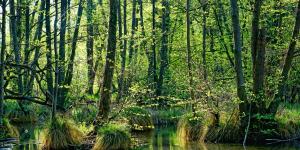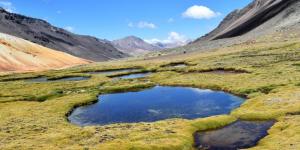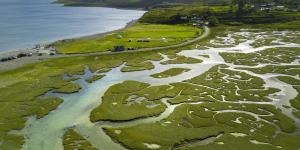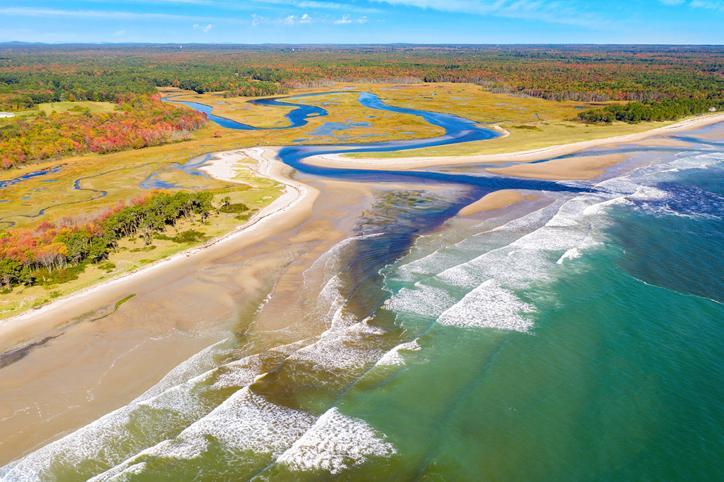What Is an Estuary? - Definition of Estuaries

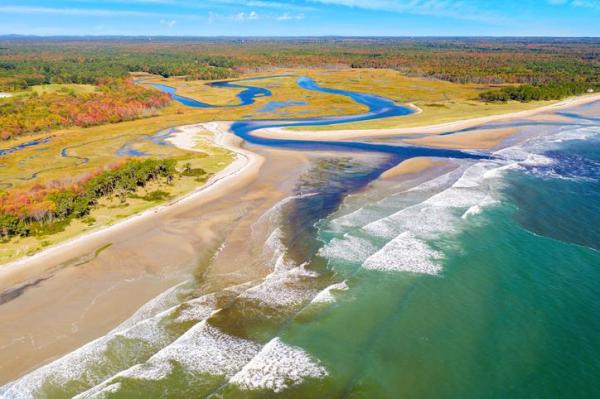
A body of water refers to various large accumulations of water which can be either natural or manmade. This means they can range from just a few feet to millions of square miles of surface area. Size is not the only defining characteristic of bodies of water. How the water flows within it, how water arrives in it and many other factors help distinguish one body of water from another. This is the case with estuaries, a body of water which occurs thanks to the influx of both freshwater and saltwater. It is for this reason, they are considered a type of mixed ecosystem.
At thedailyECO, we investigate this type of body of water by asking what is an estuary? In providing a definition of estuaries, we can get a better understanding of how this ecosystem can benefit the flora and fauna within it. We also look at examples of different estuaries in nature.
What are estuaries?
Coming to a concise definition of an estuary is not the easiest task. It is often said that an estuary is where the river meets the sea. While this is a very broad definition of an estuary, it is not particularly helpful in providing a specific idea. Instead, we can say that an estuary is:
A semi-enclosed coastal body of water that extends from the tidal limit to the open connection with the sea which has a dilution of seawater with freshwater.
The open connection is usually the tidal mouth of a river, but this is not always the case. Since it can be a little difficult to produce a concise definition, it is helpful to look at some of their common characteristics of estuaries:
- Estuaries act as a refuge for many animal and plant species that depend on this semi-closed aquatic ecosystem to live, as well as to feed and reproduce. Learn more with our article on the different types of ecosystems.
- They are classified depending on the area where the water that flows from the rivers ends, since this water can end in oceans, bays, ports, inlets, lagoons or channels.
- Once the fresh water comes into contact with the salt water, there is a high degree of turbidity (cloudiness of the water) at the river mouth.
- They are areas sometimes intended for recreational, touristic or scientific use.
- Estuaries are characterized for being among the most productive ecosystems on the planet. Compared to other areas of the same size, estuaries produce a greater amount of organic matter. Their high productivity is due to the fact that nutrients arrive from the earth that have been washed away by the rivers, in addition to the nutrients provided by the sea.
- Being a semi-closed system, there is a great exchange of materials of all kinds with neighboring ecosystems.
- They are shallow areas, allowing the light that comes from the sun to easily penetrate through the water, producing greater levels of photosynthesis. Learn more about how photosynthesis is carried out in various organisms by looking at our article on the different types of chlorophyll.
- They contain many of the species that humans consume, including crustaceans, mollusks, various species of fish and many others.
- Estuaries have the capacity to retain considerable volumes of water, preventing flooding and damage to the coast when heavy storms occur.
- On some occasions, the flow of water that comes from the rivers carries a greater volume, resulting in sediments and contaminants being removed and keeping the water cleaner in the process.
With such productive ecosystems, it should be no surprise the bioactivity in the areas in and around estuaries is often abundant. What flora and fauna are present depend on the type of estuary, as well as its location and other factors.
Learn more about how organisms interact within ecosystems with our article on the difference between biotopes and biocenosis.

Types of estuaries
Although we have explained what an estuary, its definition allows for a broad range of types that fit into the basic categorization of this body of water. Each type is generally determined by comparing the volume of freshwater coming from rivers with that of saltwater derived from the sea. Such volume is determine by the estuarine water circulation which is divided into the following:
- Salt wedge estuary: occurs when the amount of river water is greater than the amount of tidal water. In these types of estuaries there is a thin transition layer between the river water at the top and the wedge of tidal water at the bottom.
- Highly stratified estuary: the amount of fresh water entering is still greater than that of tidal water, but not by as much. The mixing of this estuary's water would end up with a more saline layer of upper water, since the waves cause the tidal water to go towards the upper part and mix with the river water.
- Lightly stratified estuary: the amount of river water is smaller than the amount of tidal water. The salinity changes both in the upper and lower layers of the estuary, due to the fact the tidal flow is very turbulent. One of the most beautiful examples of this type of estuary are fjords created by glacial movement.
- Vertically mixed estuary: the volume of fresh water is practically insignificant with respect to the tidal volume. This is because the tide dominates the estuary with its homogeneous salinity, in addition there is no vertical stratification in the water column.
- Inverse estuary: are found in areas with high rates of evaporation due to dry climates which exceeds the inflow of freshwater. This large amount of evaporation causes the salinity to increase and push the water down to both the sea and land.
- Intermittent estuary: these are those that can be of one type or another depending on the amount of precipitation, since they are located in an area where the precipitation rate is highly variable.
Know more about how the salinity of water affects ecosystems with our article on what is brackish water?

Flora of estuaries
Estuaries are made up of a highly varied flora. The most representative species of these areas are aquatic plants that can survive brackish waters. They include the following:
- Southern cattail (Typha domingensis)
- Rushes (Juncus spp.)
- Arrowroot (Thalia geniculata)
Mangroves are also present in estuaries.These are made up of tree species resistant to brackish conditions and adapted to humid soils. There are about 70 species of mangrove trees, but the most prominent are:
- White mangrove (Laguncularia racemosa)
- Black mangrove (Avicennia germinans)
- Red mangrove (Rhizhophora mangle)
- Gray mangrove (Avicennia marina)
Other mangrove-associated vegetation that is present in estuaries include seagrasses such as turtlegrass (Thalassia testudium). These grasses form walls in shallow, clear water substrates. Since some estuaries can be only one or two meters deep, they can receive an abundance of light. This can form a dense waterbed of aquatic plant vegetation, as well as influencing the development of algal blooms. There are also phytoplankton in estuaries.
Learn more about how algal blooms affect ecosystems with our article on what is a red tide?
Fauna of estuaries
As with the flora found in estuary ecosystems, the fauna which permanently or temporarily make their home is diverse in nature. Some of the animals most commonly associated with estuaries include:
- Zooplankton: the smallest animals that inhabit this ecosystem. We can find them in the water at night, but during the sunlight hours, they hide out in the lowest and darkest areas of the estuary. Zooplankton feed on suspended organic matter and phytoplankton.
- Fish: one of the many animals that feed on zooplankton are the various types of estuary fish species. They include herring, sardines, anchovies and others. These type of fish are able to thrive in the brackish waters of estuaries, although the high salinity of some estuaries might mean they are not able to live in all types.
- Crustaceans: examples of estuarine crustaceans include the blue crab , pistol shrimp and prawns.
- Mollusks: among the mollusks which can be found in estuaries are the black oyster and various clam species.
- Mammals: many of the mammals which live in an estuarine ecosystem can be found around the water rather than in it, such as the crab-eating raccoon (Procyon cancrivorus). However, many are semi-aquatic such as the harbor seal (Phoca vitulina) and the California sea otter (Enhydra lutris nereis).
- Birds: species of birds found in various estuaries include boobies, cormorants, pelicans and night herons.
- Reptiles: among the many reptile species that inhabit estuaries, the alligator stands out. These giant reptiles are endangered in various areas and need protection.
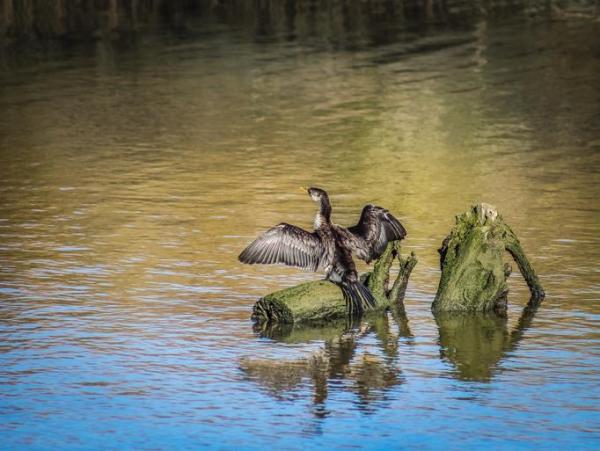
Impacts suffered by estuaries
After seeing all the characteristics of estuaries, we can conclude they are very important ecosystems for living beings. Due to their incredible biodiversity, they are of special interest for scientific studies. Unfortunately, this is often due to the fact many important estuaries are becoming threatened. This is for the following reasons:
- Pollution: they are being contaminated by pesticides, industrial and domestic waste.
- Industry: intensive fishing and cultivation are especially detrimental factors. Learn more about this issue by looking at our guide to different types of environmental degradation.
- Land development: various kinds of construction are carried out in these environments, such as dams and other structures that are used to control the flow of fresh water. These can result in the natural balance of the system to be altered.
- Leisure: the recreational use for fishing and hunting can have a strong impact if the closed season laws are not respected. The closed season laws are those that determine the time when certain species can be hunted and fished so as not to upset their balance and that of the ecosystem.

If you want to read similar articles to What Is an Estuary? - Definition of Estuaries, we recommend you visit our Ecosystems category.
- Eby. R., et al. (2022). Sea otters in a California estuary: Detecting temporal and spatial dynamics with volunteer monitoring. Ecosphere: an ESA Open Access Journal, 13(11), e4300.
https://doi.org/10.1002/ecs2.4300 - José V. Chang Gómez, Ing. M. Sc. Estuarine Processes Course: https://www.dspace.espol.edu.ec/bitstream/123456789/6230/13/Capitulo%204%20Clases%20de%20estuarios.pdf
- ICM Estuaries. CSIC (Higher Council for Scientific Research): http://www.physocean.icm.csic.es/IntroOc/lecture12-es.html






